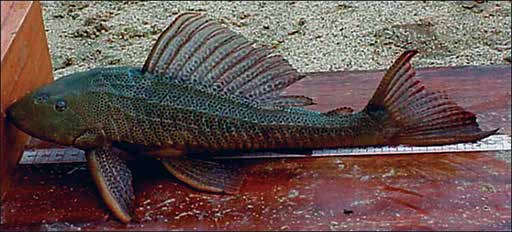Fishing for the Guaraguara or Corroncho in the delta of the Orinoco River, Delta Amacuro state, Venezuela
Abstract
The guaraguara, corroncho, panaque or cascarrón Pterygoplichthys multiradiatus (Photo 1) is a freshwater fish belonging to the Loricariidae family, the most numerous of the order Siluriformes or catfish, with 106 genera and 915 endemic species from Central and South America ( Nelson et al., 2016). Loricarids are characterized by having the body completely covered by shields or plates, and the mouth in the ventral region of the head (Photo 2) forming a suction cup; They live in rivers with strong and well oxygenated currents, even in ponds or anoxic lagoons. In the genus Pterygoplichthys, there are 16 valid species that are distributed in the Orinoco, Amazon, Magdalena, Lake Maracaibo, Paraná and São Francisco basins in South America, although they have been introduced in other regions of the world, such as the United States of America. (Florida, Texas, Hawaii, Washington, and North Carolina), Mexico, Puerto Rico, Costa Rica, Indonesia, Japan, Vietnam, Taiwan, Philippines, Malaysia, Singapore, Java, Sumatra, India, Bangladesh, and Turkey (Nico et al. , 2012), sites where they are considered pest species, due to the serious impacts they cause to other fish, the environment and fishing gear.
The guaraguara (P. multiradiatus) is a species that takes advantage of atmospheric oxygen through the stomach epithelium, so it is capable of surviving more than 24 hours out of water. Like all loricarids, the guaraguara presents a K-type life strategy, characterized by a relatively low fertility (2,000 oocytes or ovules on average), large oocytes (Photo 3) and the presence of parental care, which guarantees a high survival of the juveniles. In the case of P. multiradiatus, the males make their nests, consisting of caves, holes or tunnels on the shores of the aquatic bodies they inhabit (Photo 4), which they excavate using the odontodes or spines of the pectoral fins, where the female courted, places the mass of adhesive oocytes, the male proceeding to fertilize them and the male remains in the care of them until hatching.
References
Castillo, O. 1988. Aspectos bioecológicos sobre los peces comerciales del bajo llano con énfasis en los bagres (Orden Siluriformes). Trabajo de Grado de Maestría, Universidad Central de Venezuela, Facultad de Ciencias, Instituto de Zoología Tropical, Caracas; Venezuela. 114 pp.
Ferraris, C. J. 2007. Checklist of catfishes, recent and fossil (Osteichthyes: Siluriformes), and catalogue of siluriform primary types. Zootaxa 1418. 628 pp.
Hoover, J. J., K. J. Killgore and A. F. Cofrancesco. 2004. Suckermouth catfishes: Threats to aquatic ecosystems of the United States? Aquatic Nuisance Species Research Program Bulletin, 04-1: 1-9.
Insopesca, 2016. Estadísticas pesqueras de Venezuela. Ministerio de Agricultura y Tierras, Instituto Socialista de la Pesca y la Acuicultura, Caracas.
Mendoza, R. E., B. Cudmore, R. Orr and J. P. Fisher. 2009. Trinational risk assessment guidelines for aquatic alien invasive species. The cases for the snakeheads (Channidae) and armored catfishes (Loricariidae) in North America inland waters. Commission for Environmental Cooperation, Montréal, Québec, Canada. 98 pp.
Nelson, J. S., T. C. Grande and Wilson, M. V. H. Fishes of the world. John Wiley & Sons, Fifth edition. Hoboken, New Jersey, USA. 707 pp.
Nico, L., M. Cannister and M. Neilson. 2012. Pterygoplichthys pardalis. USGS Nonindigenous Aquatic Species Database, Gainesville, Florida, USA.
Nikolsky, G. V. 1963. The ecology of fishes. Academic Press, London and New York, 352 pp.
Novoa, D. y F. Ramos. 1982. La piscicultura extensiva en el medio rural de la región de Guayana. En: Novoa, D. (Ed.). Los recursos pesqueros del río Orinoco y su explotación comercial. Editorial Arte, Caracas, Venezuela. 263-324.
Ricker, W. 1975. Computation and interpretation of bio-logical statistics fish populations. J. Fish. Res. Bd., 191:382 pp.
Silva, A. 2012. Caracterización bioecológica de la ictiofauna dulceacuícola, estuarina y marina de los caños Macareo, Manamo y Río Grande del río Orinoco, en el estado Delta Amacuro. Informe Anual Inia, Proyecto LOCTI 07-03-08-01. 12 pp.
Sparre P. y S. C. Venema. 1995. Introducción a la evaluación de recursos pesqueros tropicales. Parte 1. Manual. FAO. Doc. Tec. Pesca. 306/1. Rev.1. 420 pp.
Wu L.W., C. C. Liu, and S. M. Lin. 2011. Identification of Exotic Sailfin Catfish Species (Pterygoplichthys, Loricariidae) in Taiwan Based on Morphology and mtDNA Sequences. Zoological Studies 50(2): 235-246.
Zar, J. 1996. Biostatistical Analysis. 3ra Ed. Prentice Hall, New Jersey. USA. 918 pp.


